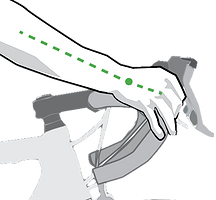BIKE SIZING &
FIT
It's a shame that we see numerous riders with a wrong size bike! This is usually not the riders' fault, but the shop which sold it to them. It is the duty of a responsible bike shop to sell you the right size frame. We would even go as far to say that it is CRIMINAL to sell you a wrong size frame.
Issues with a wrong size frame:
-
Lack of Control - You'll find it difficult to have full control over the bike.
-
Comfort - You'll constantly keep shifting on the bike to find a comfortable position, and ultimately be forced to maintain an unhealthy posture.
-
Riding over long distances can strain your body muscles especially around the wrist area and the ankle. Such a case can be even worse where you are riding the wrong size of a bike. Such a case is attributed to the fact that the wrists play a significant role since they help in turning, manoeuvring around obstacles and maintaining your position on the road. The wrong size bike can have handlebars that could be too high, too low, too far forward or too near which can cause wrist injury.
-
Many riders give up biking after a few months of purchase, without knowing that the underlying problem for discomfort is a wrong-sized frame or an ill-fitting bike.
-
Buying the correct frame size addresses only half the problem, the other half being the bike fit. Unfortunately, many also ride poorly fit bikes. Saddle height being too low is the most common. If the saddle height is not adjusted properly, you'll end up with bad knees, and it's painful!
Example of a bad brake lever position, when brake levers are not properly aligned with your arm and wrist:
POOR ARM AND WRIST POSITION



GOOD ARM AND WRIST ALIGNMENT


Remedy
-
Once you've decided what kind of bike you would like (Hybrid, Road, MTB), find out from your local bike shop (LBS) what brands they carry and what models are suitable within your budget. Once you have a list, go to the manufacturers website and see what frame size you need to buy for a particular model. Every reputed manufacturer will have a size guide for their bikes. Keep in mind that bike sizing will vary from one manufacturer to the other.
-
Once the correct frame size is selected, the shop must fit the bike as per your riding requirement/fitness. That is adjusting the seat height, adjusting the reach (stem length, sliding the seat position), aligning the brake levers with your arm line, etc.
-
If you've discomfort while sitting on your bike (seat pushing the crotch area), you can tilt the nose of your saddle slightly downwards and that'll elevate the problem.
-
If knees are aching/paining, the neck is hurting, then have the bike fit done immediately. It's usually the case of a wrong size frame or a poor fit.
-
Last but not the least, try to ride in a group with experienced/senior riders. While riding a bike sounds as simple as sitting on the saddle and pedalling, it isn't! You have to learn the proper use of gears, hand position on the handlebars, posture, spinning vs grinding, proper placement of the foot on the pedal, road awareness, signalling, bodyweight distribution, etc.
Joining WERC group rides not only teaches you the proper techniques but will also elevate your biking experience and thoroughly enjoy the joys of cycling!
Bike Size Guide
Click here for further reading